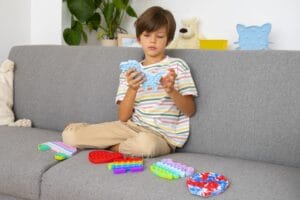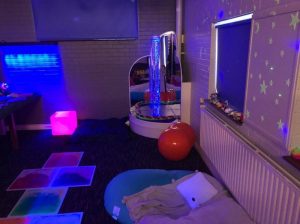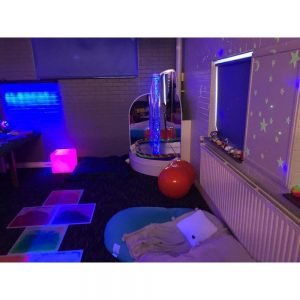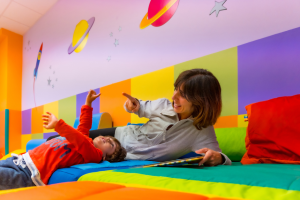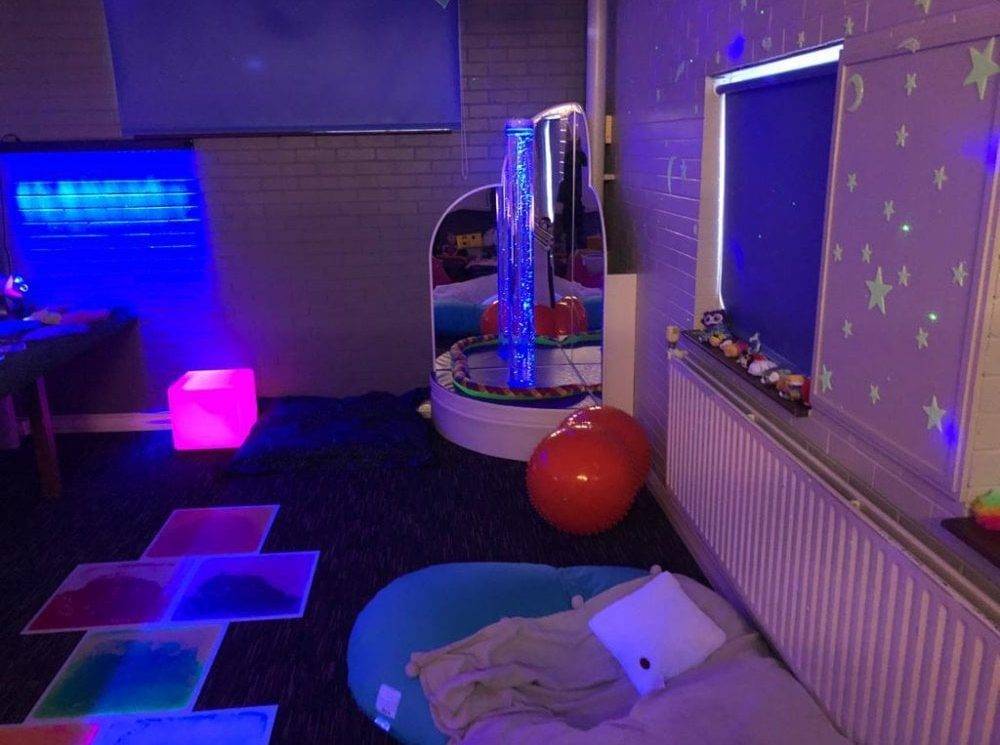Imagine starting your day with your eyes hurting from bright lights, apprehension from loud noises, and agony from touch. This is often the reality for individuals who have a Sensory Processing Disorder (SPD). Our senses play a crucial role in transmitting messages about our day to our brain. With this information, the brain is able to communicate feelings of hunger, emotions, pain, etc. Unfortunately, for those with Sensory Processing Disorder, these processes can become overwhelmed, causing anxiety, restlessness, and making communication difficult. Sensory inputs such as loud noises, touch, and bright lights can cause adverse reactions in individuals with SPD. Does a solution exist to help alleviate these issues? Fortunately, it does!
Sensory rooms have been in use since their conception in the 1970s. When two therapists discovered the benefit of providing their patients with a space where they could engage their senses. Since their creation, these inclusive spaces have become successful applications for individuals with Autism in over 400 countries. These uniquely created rooms are used to assist those who struggle with sensory overstimulation or under stimulation in learning to self-regulate.
As strategically designed areas, these rooms have become more common and are seen in public spaces such as schools, libraries, hospitals, and event venues. Sensory rooms have become so successful in helping individuals with Autism and SPD that people are installing them in their homes. Parents of children with Autism are finding this innovative space a welcome home addition because of the immediate benefits and the improvement they see in their children. With an in-home installation, parents can accommodate their child’s specific sensory needs and create a space that promotes peace and wellbeing.
Case Study – Parents Who Installed a Sensory Room for their Child with Autism
Many parents have seen the benefits of sensory stimulation in action and decided to create a space at home dedicated to helping their child engage in calming sensory stimuli. The results have been astounding! Children who previously had communication issues, information processing issues, and trouble focusing, are now seeing great improvements in these areas. The beauty of a sensory room is that it can be adapted to individual needs. For example, Nour, a three-year-old participant in a case study to explore the benefits of sensory stimulation for Autism, is not comfortable with green light and finds it overwhelming; as a result, the light in her sessions is always set to blue, the hue she prefers and feels comfortable with.
A case study was conducted with the population that attends an association for the care of children with Autism in Nablus Governorate in Palestine to understand how customized sensory spaces impact the development of children. There was a sample size of 17 children, 5 girls and 12 boys, with ages ranging between 2 and 14 years old. The sessions conducted were adapted to each child’s needs, and all the sensory equipment was involved based on each child’s treatment. If a child needed to work on their focus, the specialist would use an interactive floor with the help of a sensory light projector. The beautiful lights and colours would hold the child’s attention and prove useful in helping improve the child’s ability to maintain their concentration and composure. For specialists that wanted to work on stimulating the senses, tactile sensory equipment was used to work on interacting with their environment through touch, smell, sight, and sound.
The results of the study supported the great impact sensory stimulation spaces have on children with Autism. When the association uses the sensory room for their sessions, the children have greater focus and are able to stay in place while the specialist walks them through different activities. After consistent use, many nonverbal children began to say words such as “water” when engaging with the bubble tubes and calling out the corresponding colours when the light would change.
The association has seen higher attendance for treatment with the multisensory environment instead of a traditional office space. Parents who were interviewed expressed their joy and wonder at the improvements in their children’s behaviour and development. This study discusses the necessity of sensory stimulation spaces for people with Autism or Sensory Processing Disorder (SPD), as well as the need to establish a safe atmosphere where they can engage their senses and find comfort using various sensory equipment activities.
What Is a Sensory Room – How Does It Work?
A sensory room is an environment created to provide a comforting space for individuals with Autism or SPD. These designated areas are multimodal spaces where people can find a place away from triggering sensory stimuli. The impact that multisensory spaces have on individuals with Autism and Sensory Processing Disorders is enormous! If you’re a parent or part of a caregiver community, consider creating a sensory room for your child or children in Ireland. Are you curious about its functions and how it can be used to engage your child’s senses? Read on.
• Aromatherapy — Aroma diffusers and soothing essential oils can be used to permeate a pleasant and calming scent throughout the room. If you want to have interactive aromatherapy activities, you can use scented washable markers, scented playdough, and scratch and sniff books.
• Sensory lights — Sensory lights are used to create a soothing glow and bring peace into a space. Sensory light devices such as fibre optic sensory lights, lighted sensory walls, and projectors can be utilised to improve visual stimulation and create a relaxing ambiance.
• Music and white noise — Music and white noise are used to help create the perfect relaxing environment with soothing tones or sounds that aide in self-regulation. If children are overstimulated by sound, then fuzzy earmuffs or noise-cancelling headsets are great options.
• Edible sensory toys — If a child has sensory needs related to taste, edible sensory toys may be implemented to help them avoid excessive chewing on their clothing or other objects.
• Tactile sensory toys — Tactile stimulation may be created in various ways. Interactive sensory walls are a great way to combine different sensory stimulation and help children apply multiple senses. Sensory room equipment that has different textures, is soft, or vibrates, may produce positive tactile sensory stimulation.
• Deep pressure therapy – Children that have proprioceptive processing issues may benefit from deep pressure therapy. This sense deals with the body’s awareness of its location, position, and movement. A child with this sensory processing difficulty may seem clumsy, bump into things frequently, and enjoy spinning. Sensory devices such as body socks, weighted vests, and hugging pea pods are ideal in providing DPT.
• Wellness activities – Wellness activities may be useful in helping individuals with Autism or SPD self-regulate across all sensory stimulation triggers. But if your child has issues with processing interoceptive information, they may have difficulty understanding their body’s messages. It is important to support them with activities such as meditation, breathing exercises, and yoga. Floor mats, sofa mats, and crash pads are sensory equipment you can fit into your sensory bedroom to help promote wellness.
• Physical activity — Physical activity is important to strengthen your child’s balance and mobility. Sensory toys that create active play are essential to engage in physical activity. This is key in helping combat vestibular processing issues. Balance boards, swings, and body wheels can be used to create a fun physical environment.
The Wide Application of Sensory Rooms – Help for Children, Adults, and Psychiatric Patients
The installation of areas tailored to sensory stimulation is becoming increasingly common across Ireland. The results are creating a great impact on the Autism community. For children, adults, and psychiatric patients with Autism or SPD, these spaces are safe havens where they can learn, play, and find peace amidst overwhelming settings. Multisensory spaces are being utilised every day in common spaces and mean a great deal to the people that must deal with sensory processing disorders. If you want to learn more about the impact that sensory rooms may have on individuals with Autism or SPD, continue reading.
- Provides a safe space — A multisensory area can be adapted to an individual’s specific sensory needs. These rooms are free of crowds and provide a calming and contemplative place to centre oneself.
- Creates an interactive environment — Therapy sessions or developmental sessions are no longer dull and one note. Children and adults alike are introduced to an interactive environment that is ideal for work and play sessions.
- Produces positive outcomes — It is a place that not only promotes peace and sensory stimulation, but can be key in improving issues with socialisation, mental development, and motor skills. Often, with consistent use of a sensory room, people are notably happier and have improved sensory processing.
Why More Parents are Adopting Sensory Rooms in their Homes
Multisensory rooms are being installed in more homes in Ireland than ever before. Parents are noticing positive changes in their children after using sensory rooms in public spaces and want to bring the same comforting space into their home. Parents of children with Autism are outfitting their child’s bedroom with toys and equipment to turn it into a sensory bedroom. If you’re interested in learning more about the advantages of adding a sensory room to your home, keep reading!
- Improved relationships – Establishing a sensory room and completing sensory activities together helps foster stronger relationships between parents and their children.
- Promotes independence – When children have a place to support their sensory overstimulation or under stimulation, they can learn to regulate their overwhelming sensory inputs on their own
- Improved communication – Parents are better able to recognize when a sensory input is overwhelming their child and which sensory toys will help them relax.
- Provides happiness – The joy and comfort children experience when using a sensory room is more than enough reason for parents to install one in their home. They are safe spaces for children to experience their emotions, engage their attention, and centre themselves.
The Diversity of Sensory Rooms – One for Every Budget, Scale, and Needs
Multisensory areas are versatile spaces that can be adapted to your child’s sensory needs. A sensory room specialist can help you create a multisensory environment that is tailored to your child’s personality and preferences. If your child experiences sensory overload or sensory underload, there are three variations of sensory rooms you can consider. If you’re in need of some inspiration, take a look at these ideas for each type of space.
- Calming — If your child is dealing with sensory overstimulation, a calming space is the best solution to help them de-stress. A sensory room expert can install equipment such as sensory projector lights, hugging pea pods, and sensory light tables.
- Interactive — An interactive space can help children who have sensory underload issues. Interactive rooms help individuals with Autism engage in active play. An expert can help you design an interactive sensory space with the use of sensory room equipment such as sensory wall toys, beans bags, and a sensory ball pit.
- Combination — A combination room can help your child that may have varied sensory processing issues. To fully address your child’s sensory needs, a specialist may install a wide variety of sensory room equipment. There are sensory toys that can tackle a variety of senses making them ideal for a combination room. Equipment such as bubble tubes, cocoon hammocks, and sensory wall panels are both calming and interactive devices that can help your child self-regulate.
A multisensory area in your home can be customized with your child’s favourite sensory toys and equipment to create a space that is personalised to their preferences. The amazing thing about these spaces is that the range of equipment can create effective change with even the smallest amount of room and accessible items. Total Sensory Solutions specialists can help you build a multisensory space that aligns with your vision and is suited your budget and scale.
We are a premier sensory company with over 25 years of experience in the industry. As a leading supplier of sensory room equipment in Ireland, we make it our mission to develop and install spaces that meet your child’s sensory needs.
If you’re interested in installing a sensory room in your home— call us on 01 8414933 or send us a message.

